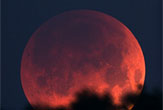How to Watch the Lunar Eclipse with Low-Tech Gadgets

Residents of North and South America will be in for a rare treat early Tuesday morning when a total lunar eclipse coincides with the winter solstice for the first time in 372 years.
The rare celestial spectacle will be so big and so bold that the only equipment you'll need to experience it are your eyes, but the use of some simple technology could help make the event even more memorable.
"Rather than looking one dimensional in the sky, the moon will appear to be 3-D and resemble a big red Christmas ball in the sky," said Joe Rao, an instructor and guest lecturer at New York's Hayden Planetarium. "In fact, when looking at it with binoculars or a small telescope, you will see the terrain of the surface resemble Mars too."
The total lunar eclipse occurs when the Earth maneuvers between the full moon and the sun and prevents the sun's rays from bouncing off the lunar surface. Total lunar eclipses are relatively rare, but this event is especially unique because it also falls on the winter solstice, which marks the official beginning of winter in the northern hemisphere. It is also the darkest, longest night of the year, making it particularly suitable for sky watching.
During the winter solstice, the sun is at its lowest in our sky because Earth’s North Pole is tilted farther away from it than at any other time of the year.
Rao believes the most magnificent time to see the moon early Tuesday morning on the East Coast will be when it's in totality, or in the Earth's shadow. This will occur twice: between 2:35 a.m. and 2:41 a.m. EST and then again from 3:53 a.m. to 4:00 a.m. EST.
While no special equipment is necessary to see the eclipse, a simple pair of binoculars should bring out features of the lunar landscape that might not be visible otherwise.
Sign up for the Live Science daily newsletter now
Get the world’s most fascinating discoveries delivered straight to your inbox.
"Binoculars are lightweight, portable and less expensive than a telescope, plus if you are cold you can just run back inside your house instead of packing up a large piece of equipment," Rao said.
Amateur astronomer Geoff Gaherty of Starry Night Software recommends that skywatchers use 7x50, 8x40, and 10x50 binoculars because they are easy to hold when viewing the eclipse.
"Binoculars which need a tripod will not work well since the eclipse will be high overhead for most North American viewers," Gaherty noted.
Lunar eclipses take place slowly over a period of several hours, so the good news is that you won't miss it if you blink.
Capturing the eclipse
Tuesday's eclipse might also be a good time to try your hand at lunar photography, Gaherty said, since the moon will be so bright that almost any camera will turn out decent photos.
"This eclipse is unusual because it occurs when the moon is located in the Milky Way," Gaherty said. "From a dark sky site, it should be possible to photograph quite a few background stars along with the eclipsed moon – a wonderful three-dimensional effect."
Gaherty recommends using a telephoto lens or your camera's maximum zoom, "as the moon always photographs a lot smaller than it looks to the eye. A wide angle view can also work well if there's enough illumination in the foreground."
Another tip: If you usually use a filter on your lens, take it off for this event. "Otherwise you may get a nasty ghost image of the moon," Gaherty said. "You can ruin a beautiful set of eclipse pictures this way."
Underexposing the camera may also help bring out the moon’s color, Gaherty advised, especially when the eclipse approaches totality.
If you want to get fancy, you can also try holding your camera up to a telescope viewfinder to capture a more detailed image.
"If you have a digital camera, you can put it in front of a telescope to see an impressive, magnified picture," Hayden Planetarium's Rao said. "The great part about digital cameras is that you can play around with the exposures and readjust the angle after seeing your shots. In the past, we would spend so much money developing film and 97 percent of the images wouldn't turn out right."
When and where to see it
It's no secret that being away from big lights and cityscapes will give you a better view of the sky, but any location experiencing nighttime during these hours should provide a view of the eclipse, even in partly cloudy skies, Rao said.
However, no amount of technology will help if the weather in your area doesn't cooperate.
"Chicago, New England and parts of the Western United States will be eclipsed by clouds, and that’s something that technology can’t do anything about," Rao said.
If you miss Tuesday’s event, your next chance to see a lunar eclipse on the winter solstice won’t be until 2094.
Reach TechNewsDaily senior writer Samantha Murphy at smurphy@techmedianetwork.comThis e-mail address is being protected from spambots. You need JavaScript enabled to view it . Follow her on Twitter @SamMurphy_TMN.










